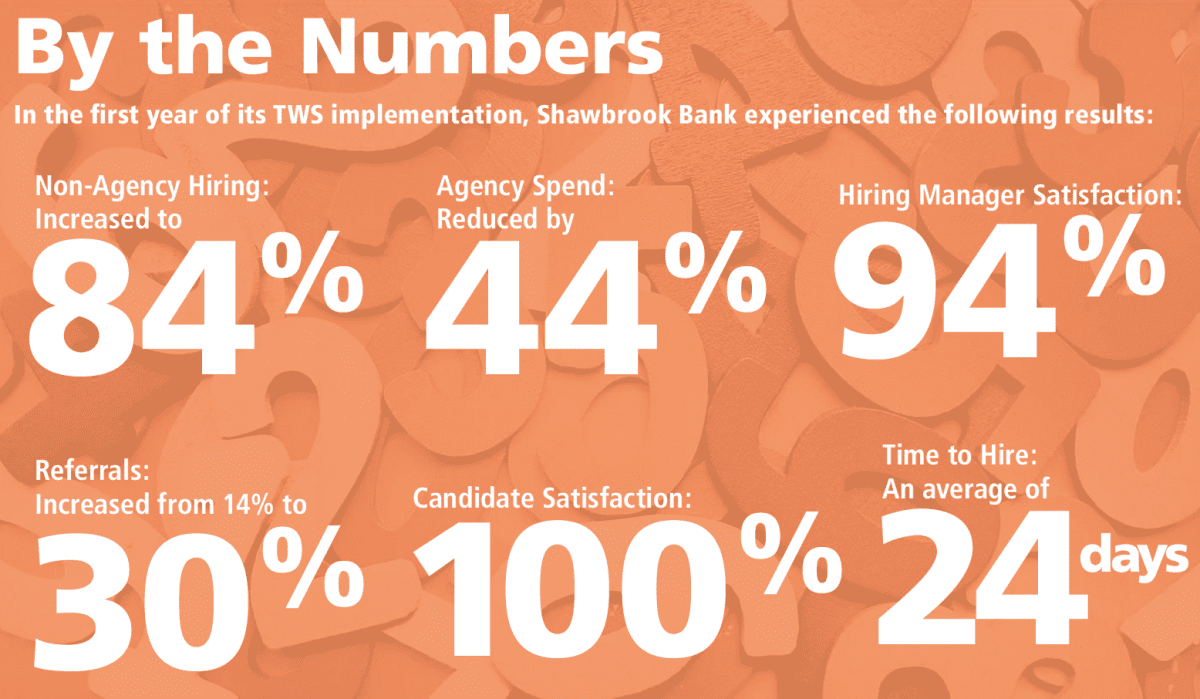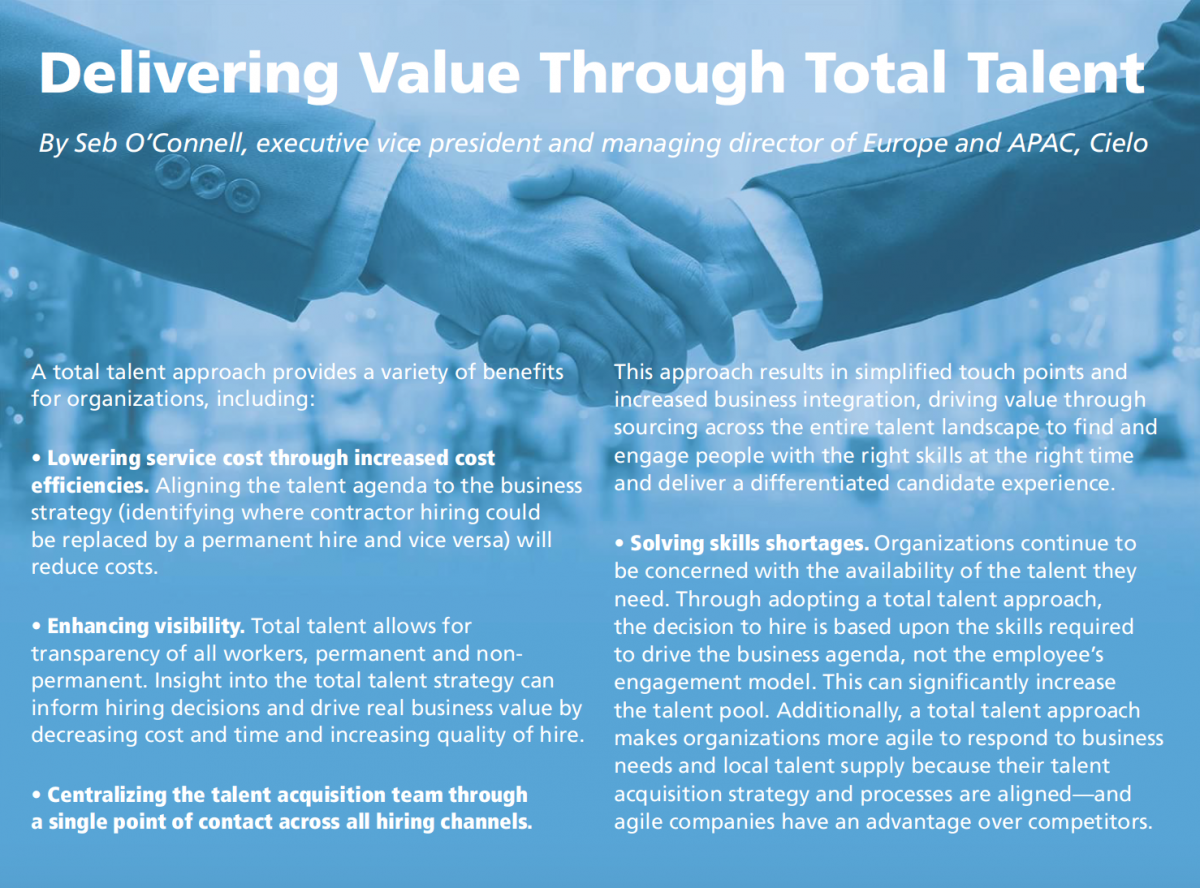Total workforce solutions provide full visibility into the workforce, but how can organizations ensure a smooth transition?
By Marta Chmielowicz
Today’s talent ecosystem offers more options for employees than ever before. From online freelancing platforms to crowdsourcing efforts and traditional contract engagements, the contingent labor market is experiencing a revolution -and businesses are struggling to keep up.
“The fact of the matter is we’re at full employment, and the fact that we’re in a candidate-driven market means that increasingly, employers aren’t the ultimate arbiters of how work gets done -and thanks to the major evolutions we’ve seen both in technology and professional preference, more of that traditional work is getting done by workers who are anything but,” says Bruce Morton, head of strategy at Allegis Global Solutions.
According to Ardent Partners’ 2017-2018 State of Contingent Workforce Management study, 40 percent of today’s total global workforce is comprised of non-employee talent and that number is only expected to rise. However, 68 percent of this talent is unaccounted for in the average organization’s budgeting, planning, and forecasting.
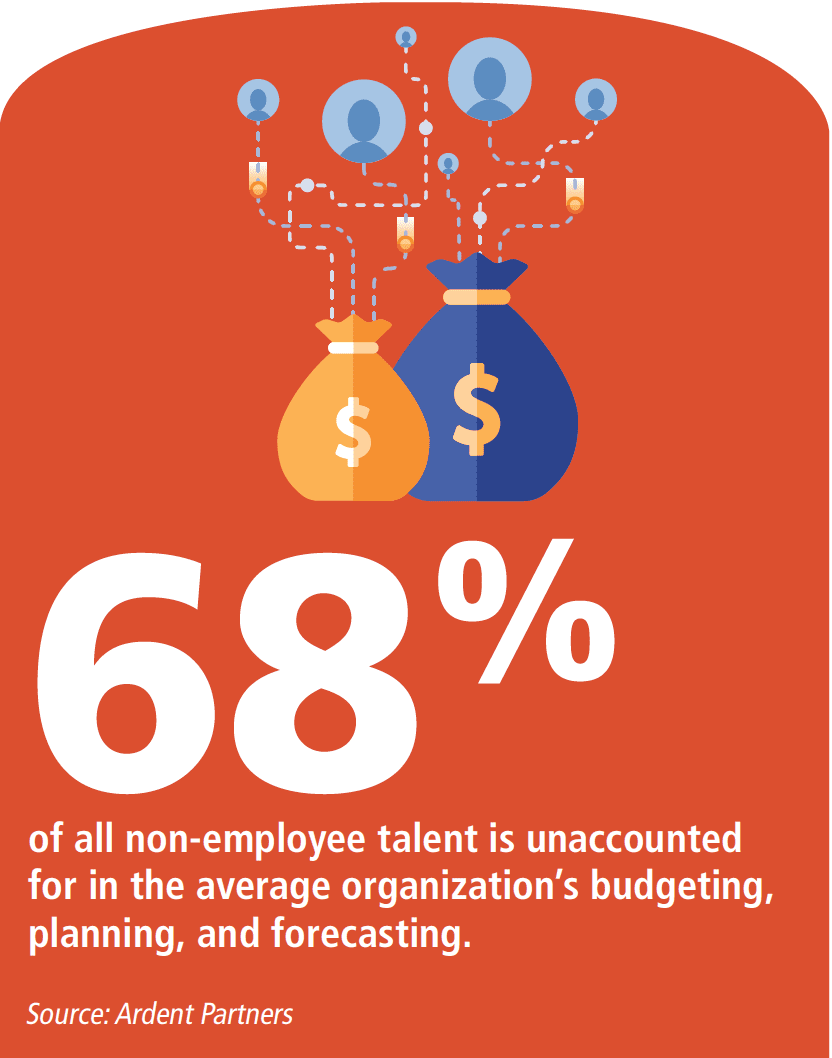 Companies lack sufficient visibility into this vital segment of the workforce and it is costing them in the war for talent. By continuing to approach talent management with a siloed approach where HR manages permanent hires and procurement manages temporary workers and independent contractors, businesses can miss out on opportunities to improve ROI, embrace transparency, and transition into a more strategic HR function. In fact, Ardent Partners’ research shows that 67 percent of best-in-class organizations prioritize active collaboration between HR and procurement compared to only 38 percent of all others.
Companies lack sufficient visibility into this vital segment of the workforce and it is costing them in the war for talent. By continuing to approach talent management with a siloed approach where HR manages permanent hires and procurement manages temporary workers and independent contractors, businesses can miss out on opportunities to improve ROI, embrace transparency, and transition into a more strategic HR function. In fact, Ardent Partners’ research shows that 67 percent of best-in-class organizations prioritize active collaboration between HR and procurement compared to only 38 percent of all others.
How can companies seize these opportunities and embrace the workforce of the future head-on?
One approach is to adopt a total workforce solution (TWS). TWSs combine recruitment process outsourcing (RPO) and managed service program (MSP) capabilities into one total talent strategy that provides cost savings and enables a blended approach to talent acquisition and management. By harnessing a TWS to tap into existing on-demand talent that fits the exact requirements of the business, organizations can thrive in the world of work.
Reasons to Turn to Total Talent
According to Michael Yinger, global leader of growth and strategy at PeopleScout, moving from a segmented to a holistic total talent approach can provide significant cost savings thanks to its ability to:
- streamline the recruitment process, reducing overlap between MSP and RPO functions;
- deliver insights that allow for quicker and more strategic hiring decisions; and
- simplify recruitment management and reporting, saving recruiters valuable time for higher-quality tasks.
“A total talent strategy provides companies with a broad view of the workforce across different labor classifications and departments,” Yinger says. “That level of visibility allows organizations to gain consolidated intelligence into their workforces and helps them evolve in the competitive talent landscape.”
But the business benefits of a TWS extend beyond cost savings. Randstad Sourceright‘s Senior Vice President of Solution Design James Stovall says that a total talent approach can also help provide access to the best available talent. “Many companies are unable to quantify talent quality because it is difficult to measure the impact of employees with different managers responsible for completely separate talent silos,” he says. “Given the historically low availability of talent, the most compelling business case for companies to pursue a total talent model is the ability to quantify talent needs and fill openings with quality talent faster.”
Shawbrook Bank and Waste Management are two companies that have embraced total workforce solutions and are already experiencing benefits. Through their total talent management programs, both companies have expanded their employer brand, increased efficiency, and improved candidate experience.
“Our TWS model goes beyond simply making sure Shawbrook attracts the right talent that is needs to continue its growth. It has enabled the bank to become a true talent magnet,” says Lee Shaw, head of HR service delivery and change at the company (see By the Numbers to learn about the impact of Shawbrook’s TWS).
Making a Business Case
But even with these benefits, many HR professionals struggle to secure buy-in from senior leadership due to the complexity of the change management process and the lack of precedent and resources to assist with the transition. A good place to start is by building a business case that addresses key organizational challenges. “Overcoming organizational inertia starts with understanding your company’s strategic goals and determining how to tailor your talent strategy to achieve those objectives,” Yinger says.
In the case of Waste Management, the key strategic goals were to deploy talent faster and provide a positive employee and customer experience. “We were really looking at how to get people deployed quicker, recognizing that as positions open or stay open waiting to be filled, that impacts our customers’ experience as well as the experience of our employees who are trying to fill that gap,” says Lon Harvey, director of Waste Management’s contingent labor program. “So, it’s important for us as a customer-focused organization to support the customer experience and having a fully staffed organization is very critical to making that happen.”
The Waste Management team looked to leverage new technology to deliver a highly digitized, transparent, and cohesive total talent solution that offers all types of candidates continuity across platforms and presents them with a broader view of possible opportunities. By evaluating the experience and needs of their candidates, Waste Management built a business case for their talent technology investments.
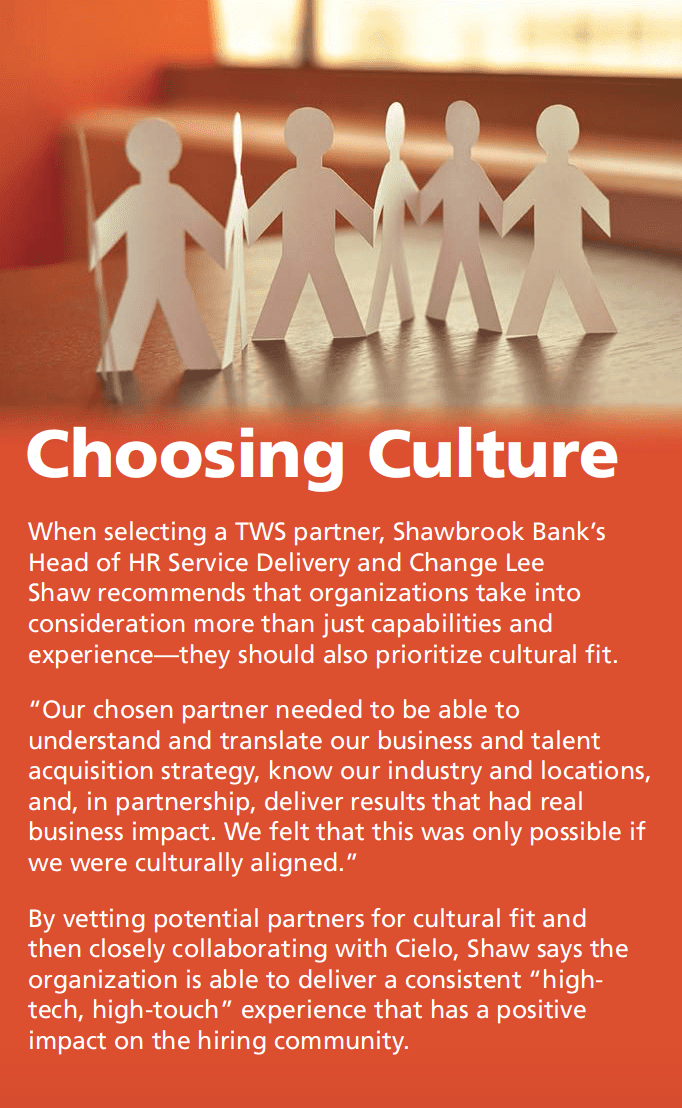 For Shawbrook Bank, its approach focused on creating a talent acquisition strategy that encourages growth and addresses resourcing challenges. The organization built its business case by demonstrating how a TWS can reduce external supplier costs and improve employer brand.
For Shawbrook Bank, its approach focused on creating a talent acquisition strategy that encourages growth and addresses resourcing challenges. The organization built its business case by demonstrating how a TWS can reduce external supplier costs and improve employer brand.
“The argument Shawbrook made to secure buy-in from key stakeholders was the urgent need to reduce high-cost agency reliance through increasing direct hire and referrals, which previously sat at 14 percent,” Shaw says. “In deploying a single provider and having one consultative point of contact for hiring managers to access for any type of resource -permanent, executive search, temp, contractor, early talent, fixed term -we could maintain cost control while delivering a consistently strong talent acquisition experience, both for hiring managers and for candidates.”
Yinger says that it’s important for organizations to establish a baseline that delineates their actual labor costs for every type of employee as well as the current procedures for determining how labor classifications are made. “By evaluating the current workforce mix and costs, leaders can understand cost discrepancies through different functions of the organization. For example, an organization may discover it has long-term contractors with bill rates that are double the cost of a permanent hire,” he explains.
According to Seb O’Connell, executive vice president and managing director of Europe and APAC at Cielo, this evaluation should include the following metrics:
- total spend;
- total number of hires;
- source of hire;
- number of open requisitions;
- time to hire;
- quality of hire;
- hiring manager satisfaction; and
- candidate satisfaction by employee engagement type.
By bridging existing silos and consolidating all available labor data into one resource, HR professionals will be better equipped to evaluate the amount of overlap in the workforce mix, which Randstad Sourceright’s Stovall says is key. “The question is: Will an integrated approach give you a competitive advantage? To find out, I typically look to see if the categories of talent sought from full-time and contingent overlap, because the greater the overlap, the greater the benefits,” he says.
Ensuring a Smooth Transition
Organizations that gain the support of their senior leadership in transitioning to a TWS still face a major obstacle -implementation. Merging two segmented talent sourcing models comes with a unique set of challenges, including integrating separate process and data systems.
“Often, traditional employees, whether exempt or nonexempt, have everything from their job applications to their performance reviews to their core HR data housed in completely separate databases or systems than their contingent counterparts -even those doing essentially the same job function. And, of course, those systems aren’t always designed to talk to each other or provide the kind of consolidated reporting and holistic look into an organization’s total talent picture and that’s the impetus of a TWS implementation in the first place,” says Allegis’ Morton.
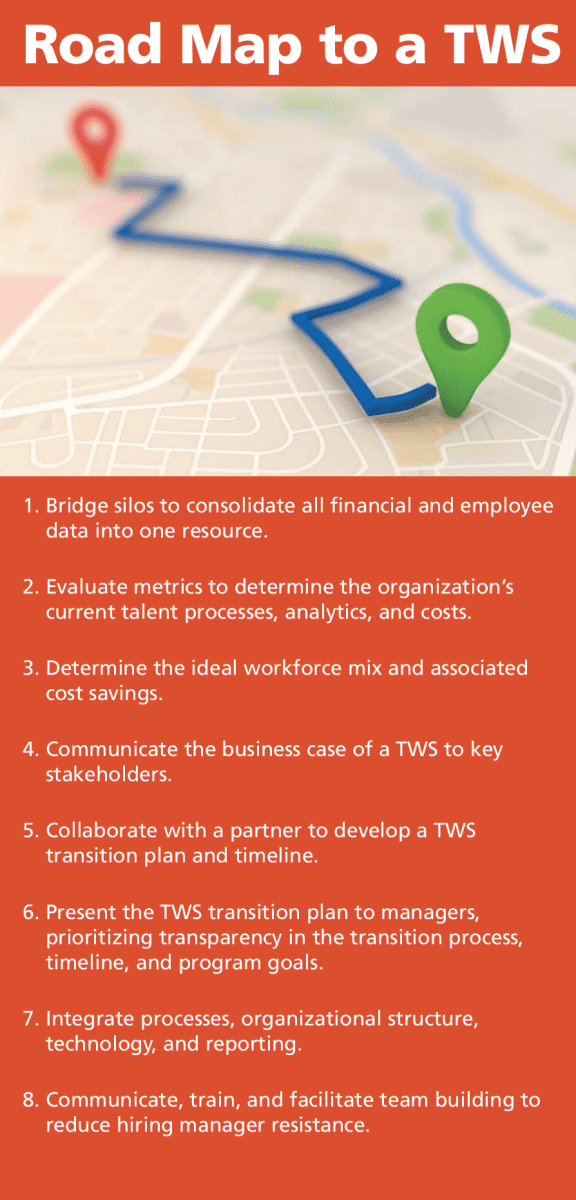 For Waste Management, the solution to the integration equation was technology. According to Harvey, the company’s journey toward a total talent strategy started with finding the right technology and analyzing how it would alter service delivery.
For Waste Management, the solution to the integration equation was technology. According to Harvey, the company’s journey toward a total talent strategy started with finding the right technology and analyzing how it would alter service delivery.
“The big driver here is technology,” he explains. “That’s going to create some big changes in the services map in terms of how we provide services to our client managers as well as our candidates, so we really worked to understand and map out how those changes were going to happen. Why would we keep the same service delivery channels and processes if we’re able to leverage technology and this road map for TWS to do work better? So, planning how we’re going to operate internally in talent functions to best leverage the technology platform and bring these together was a big part of the process.”
By building change plans early and committing to the goal of providing a singular application experience, Waste Management was able to facilitate a smooth transition to a new system while maintaining a high-quality candidate experience that strengthens their brand.
In addition to considering the impact on service delivery, organizations should leverage data to plan the perfect workforce mix for maximum cost savings.
“In America, the average employee’s benefits and indirect compensation clocks in at about two thirds of their total salary, meaning that we’re already paying a premium of 67 percent for full-time employees, plus there’s all the associated compliance and legal risks associated with the traditional employment model,” says Morton. “What company wouldn’t want to figure out how to get the same skills and capabilities without the associated risks and costs if they could? This is why measuring worker lifetime value is so important.”
Morton says that if organizations utilize worker lifetime value metrics, they can evaluate which types of workers are going to get the work done to a high quality standard and at a good value to the company. They can then use those guidelines to tailor their total talent strategy for greater efficiency.
The Keys to Communication
But even with a perfectly designed transition plan, the switch to a TWS can be wrought with manager anxiety and resistance to change.
“In practice, the TWS model is highly effective and efficient, but gaining hiring manager buy-in to a single solution needs to be managed carefully as the concept of change or loss of control is extremely emotive,” O’Connell says.
Consistent and transparent communication can go a long way. Harvey recommends that managers proactively work to quell any fears. “We’re really managing the change process to be intentional about what changes are happening when so that there is an organic flow through getting from legacy state to target state,” he explains. “A big aspect of this is understanding the human element of our stakeholders. We’re talking a lot about technology in our organization, but we have to continue to remember we’re dealing with people at the end of the day, so how do we continue to support them while building expectations, creating transparency, and reducing fear as we go?”
According to Harvey, a three-tier approach to communication that goes from large to smaller and smallest is most effective:
- First, organizations must explain the broad benefits of the TWS to the business in relation to the marketplace as a whole.
- Next, they should communicate the benefits on the company level, touching on things like customer experience, talent deployment, and cost savings.
- Finally, HR professionals can discuss the impact on talent advisors and managers themselves, communicating the ways that their day-to-day responsibilities will change.
Considering manager feedback when designing the transition process also makes a big difference, says Shaw. “Cielo undertook several ‘voice of the customer’ sessions to really listen to our hiring managers and understand their specific challenges and nuances. Only then were our ‘to-be’ processes designed through the lens of the experiences of the hiring manager and the candidate, and this worked really well.”
This approach allowed Shawbrook Bank and their partner to gain credibility and trust from their employees, which was further cemented by consistent and culturally-aligned communications from both organizations.
The key takeaway for a TWS success? “Design through the lens of the stakeholders, hiring managers, and candidates so that you create a consistent, best-in-class experience (regardless of contractual engagement) that resonates with your brand and culture,” Cielo’s O’Connell says. “Remember that the transition does not stop at the go-live date -this is an opportunity to develop a talent strategy road map fully aligned to business objectives.”
LEARN MORE
[metaslider id=12258]

